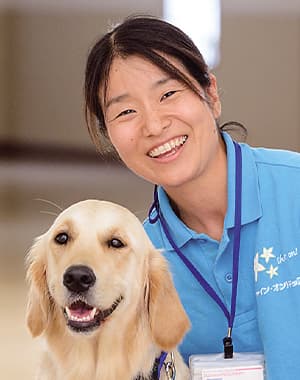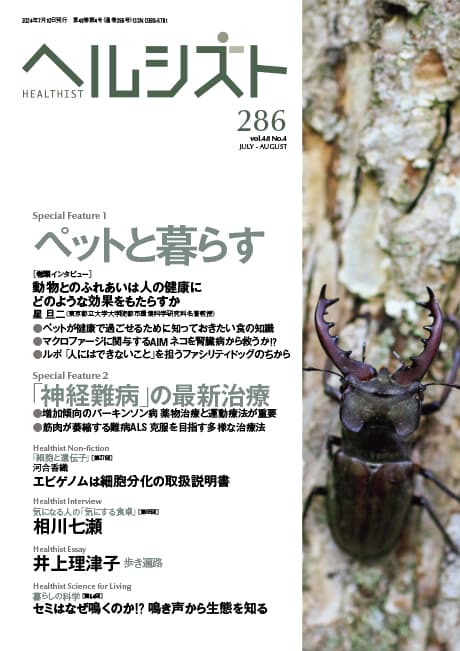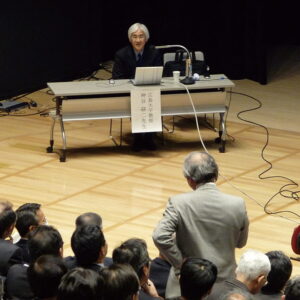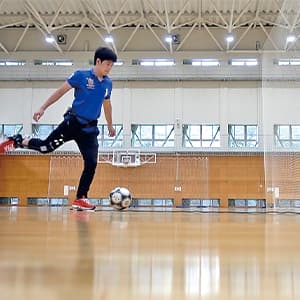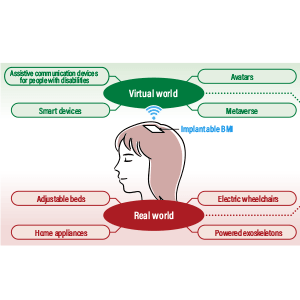Hospital facility dogs are a special type of companion animal that are hand-picked while they are puppies and undergo two years of advanced training at a dedicated facility. Only then can they carry out their role. Working at hospitals and the like, hospital facility dogs provide comfort to everyone at the facility, especially to the patients. Providing support in situations involving a particularly substantial psychological burden is an important job that only hospital facility dogs can do, and the positive effects they have are steadily increasing. However, as only a very limited number of Japanese hospitals have introduced hospital facility dogs to date, more widespread support is needed.
Special Feature 1 – Living with Pets Special Report
The power of hospital facility dogs: Doing what humans can’t
text by Rie Iizuka
“Hospital facility dogs” is the collective term for dogs that belong to a particular facility and undertake activities as a member of staff. Today, in Japan, hospital facility dogs principally support hospitalized children and their families.
Providing comfort to hospitalized children is important
Japan’s first hospital facility dog was introduced in 2010 at Shizuoka Children’s Hospital. Hospital facility dogs were subsequently introduced at Kanagawa Children’s Medical Center in 2012, Tokyo Metropolitan Children’s Medical Center in 2019, and the National Center for Child Health and Development in 2021, and there are now hospital facility dogs working at four hospitals in Japan.
We visited one of these, Kanagawa Children’s Medical Center (KCMC).
Providing highly specialized medical care to children, KCMC consists of three facilities: the General Hospital, the Institute for Physically Disabled Children, and the Institute for Children with Profound Multiple Disabilities. It is here that Yuko Morita from Shine On! Kids works as a handler, with hospital facility dog Annie.
When I knock on the door of the office, both Morita and Annie appear in the doorway. Annie has a calm and relaxed demeanor, with no hint of apprehension, and appears eager to play.
The job of a hospital facility dog is to comfort children who have been admitted to the hospital. The dog might go around visiting the children’s rooms, interact with them, or play ball or go for walks with them, but she also accompanies them to the operating theater or comforts them when they have blood taken or other procedures carried out. A hospital facility dog works from 09:00 to 16:00 every weekday, and has an hour’s break after each hour performing its duties.
In a hospital with 430 beds, it is impossible for Annie to visit everyone’s room in a single day, so Morita checks the schedule for the wards where they are working that day and coordinates their movements after assessing the cases together with physicians and nurses.
“Sometimes we’ll go to a child’s bedside, but if the children are playing in the playroom, we’ll also go there,” Morita says. If a child has to receive sedation, Annie sits beside the table and puts her chin on it, watching over the child where the child can see her. If the child needs to have an injection, she snuggles up with them on the bed or allows them to stroke her.”
- *Sedation: The administration of medication to quell agitation, with the objective of alleviating pain and distress arising from a procedure.
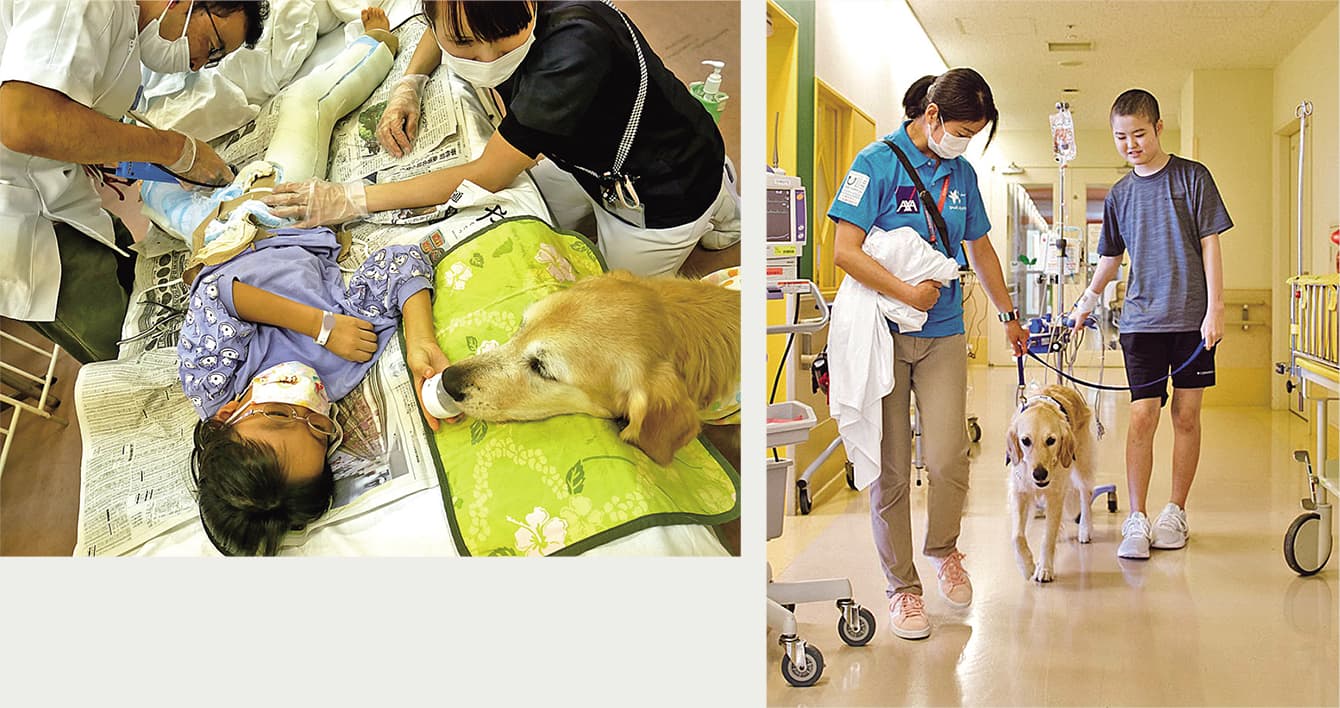
Figure 1. Providing comfort during treatmentThe dogs help to bring out more positive feelings in children through activities such as watching over them at their bedside during procedures and walking with them during walking rehabilitation.
“Today, we went to support children doing rehabilitation,” Morita continues. “For example, if the child is practicing extending their arms, they hold a toy that makes a noise and Annie taps or presses it with her nose. They switch the toy from one hand to another, extending their arms as they do so, and this extension of play serves as rehabilitation. If we want to increase the amount of activity, we often play treasure hunt games. The child hides a toy somewhere in the ward and Annie goes to find it.”
Bringing out the ability to persevere for themselves
There are other examples of the way in which Annie helps children to approach their treatment in a positive frame of mind.
“I’m actually always with Annie, so I don’t know what the children are like when Annie’s not there,” Morita says. “There is a child in the psychiatric ward, whose whose medical records say that they are prone to shouting and violent behavior, but I’ve never once seen those children behave that way.”
“Just the other day, I saw a child who’s always irritable, say, ‘Annie, just wait a moment.’ as they were facing the wall and trying to calm down. That child didn’t want Annie to see them while they were annoyed,” Morita explains.
“Sometimes a child who had been unable to set foot in a treatment room will be able to enter it if Annie walks in there with them. I also heard that a child who Annie always accompanied to radiotherapy sessions was scared and crying one day when Annie had a day off.”
“Before I was a handler, I was a nurse in a surgical department,” Morita says. “When I was a nurse, if a child just wouldn’t take their medicine, the nurses would have to put it in their mouths. If a child struggled when we set up an intravenous drip, we’d have to use towels to restrain them. No medical professional likes having to do these things. This is exactly why I myself learned, through the activities of hospital facility dogs, how important it is to bring out children’s ability to persevere for themselves.”
“You can see that, when children feel well, they act like an older sister or brother to Annie, but when they aren’t feeling well, they depend on Annie.”
Annie provides a tremendous amount of emotional support to children, both when they feel strong enough to persevere and when they are distressed.
Hospital facility dogs also visit places with infants and toddlers; are their effects apparent even in babies just a few months old?
“Tiny babies aren’t always very aware of a hospital facility dog,” Morita says. “These visits are more for their family members. Even if there’s no clear response from the baby, getting the child to stroke the dog seems to provide the family with a great deal of comfort. Some of them pour out their feelings as they take photographs with Annie and cuddle her.”
Apparently, quite a few family members have told Morita that they themselves look forward to Annie’s visits more than their child does. During our interview, Morita receives a delivery of strawberries —— Annie’s favorite food —— from the parent of a child that Annie had previously worked with.
“We also visit the rooms of children who are in the terminal phase of illness,” Morita explains. “When we do, she brings a smile to the faces of the family members and medical staff in the room. It’s because Annie regularly spends time with children and their family members that everyone smiles when they see her (Figure 2). Hospital facility dogs can do things that humans can’t.”
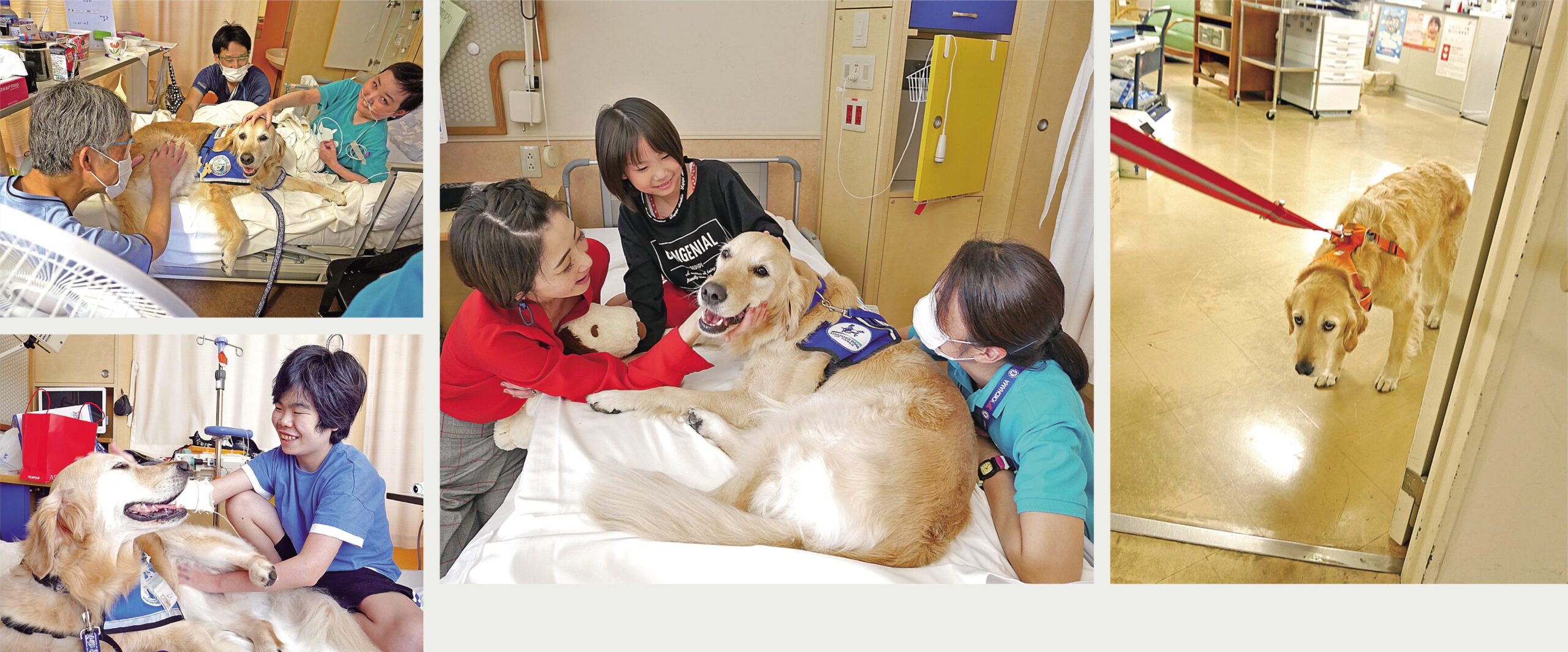
Figure 2. Watching over daily lifeWhen not required to accompany a child during a procedure, the dogs go around visiting the patients’ rooms and interact with the children and their families. Before long, everyone is smiling. Sometimes Annie stands her ground, as if to say, “I don’t want to go home yet!”
A nurse stops by and thanks Morita for her help earlier.
“I was called to see a child who’d said they didn’t want to take their medicine,” Morita explains. “This child was very strong-willed —— once they’d refused their medication, they were adamant that they wouldn’t take it, but once Annie went, they took the medicine without objecting to it.”
For the nurses and other hospital staff, Annie is a most dependable colleague.
“They truly adore her. One nurse mentioned that petting Annie helps ease their mind.” (Figure 2)
When I ask Morita what left the biggest impression on her in her career so far, she tells me about an experience when the hospital facility dog program had only just got started.
“When we launched the program at Shizuoka Children’s Hospital, I worked with a hospital facility dog called Bailey. To start with, it was possible for people to stroke Bailey in the lobby only, and we weren’t allowed onto the wards. Because we couldn’t enter the intensive care unit (ICU), any children who wanted to meet Bailey had to come down to the ward entrance.
However, there was a child who adored Bailey and whose expression and energy would transform in an instant when they were with him. Seeing that, the chief physician in ICU gave permission for Bailey to go into ICU. I think even that doctor had a negative view of hospital facility dogs at first. However, each time I met them, they’d say, “Please help that child.” Eventually, the number of wards that Bailey was allowed to enter increased, and he was even permitted to accompany children when they were undergoing procedures. Now, the hospital facility dog there is even able to be with children at sites requiring rigorous hygiene management, such as bone marrow punctures and lumbar punctures,” Morita says.
At KCMC, too, hospital facility dogs can go anywhere, even the clean ward, which has the most stringent hygiene management standards.
Handlers also play a crucial role
Shine On! Kids, the primary organizer of Hospital Facility Dog activities in Japan, was founded by its president, Kimberly Forsythe. Forsythe’s own son died from complications of infant leukemia and this experience led her to establish the forerunner of Shine On! Kids, the Tyler Foundation, in 2006, based on a desire to help children battling pediatric cancers and their families.
After undertaking a number of projects, Forsythe decided to set up a hospital facility dog program, having seen such dogs in the U.S. The path to actually securing the introduction of hospital facility dogs in Japan must not have been smooth. However, little by little, she succeeded in gaining understanding and, in 2021, hospital facility dogs were introduced at the National Center for Child Health and Development, which plays the most pivotal role of all Japan’s 15 government-designated core hospitals for pediatric cancer treatment. Head researcher at Shine On! Kids, Natsuko Murata, explains more.
“We’ve developed the program with reference to examples in the U.S., but as the medical systems in the U.S. and Japan differ, we are also modifying the system for providing this service. In the U.S., medical staff —— including nurses, clinical psychologists, and occupational therapists —— from the medical institution itself serve as hospital facility dog handlers at institutions that have introduced them, but in our case, we dispatch a handler along with the hospital facility dog.
The handler must be a medical professional with at least five years of clinical experience, and must also have undergone training in working with the dogs. This qualification standard has been put in place to increase the acceptance of hospital facility dogs at Japanese hospitals. It’s a system without precedent worldwide. We attached importance to ensuring that the handler can go anywhere in the hospital as a member of medical staff, in order to support hospitalized children and their families. Accordingly, we appoint as handlers full-time medical professionals who can operate throughout a hospital in a cross-departmental way.”
Murata says that when they first launched their hospital facility dog program, they met with a very negative response, with issues raised including hygiene concerns, questions over whether the dogs would be able to behave appropriately, and worries about children developing allergies. However, when the organization distributed a questionnaire to physicians, nurses, and non-clinical staff at hospitals where hospital facility dogs had been introduced, hardly anyone expressed skepticism about the efficacy of hospital facility dogs.

Figure 3. How hospital facility dogs spend time offA dog’s suitability for becoming a hospital facility dog is assessed by giving them experience of all kinds of treatment settings. During their breaks, they are spoiled by hospital staff, while on their days off, they get to express their highly diverse personalities, having a lot of fun and maybe showing their mischievous sides.
Psychosocial support is their principal purpose
A joint study with Shizuoka Children’s Hospital and Kansai University that was published in 2023 found that medical professionals rated hospital facility dogs as being particularly useful in palliative care at the terminal stage. Precisely because hospital facility dogs can interact with patients from the time they are admitted to hospital, they can demonstrate their capabilities in palliative care, which requires intervention from an early stage. Some medical professionals have said that, when a hospital facility dog entered the room of a child at the terminal stage, the whole atmosphere in the room changed.
“Most studies of end-of-life care in cases of pediatric cancers report that nurses and doctors should speak to the patient every day,” Murata says. “On the other hand, many medical professionals face a dilemma, in that they don’t know what to say to the patient. Here, hospital facility dogs have been able to demonstrate their capabilities as “experts” in nonverbal communication. Having handlers capable of making judgments in clinical situations is also crucial.”
The status of assistance dogs such as guide dogs, mobility service dogs, and hearing dogs is established under a law called the Act on Assistance Dogs for Physically Disabled Persons, but their purpose is providing physical support. Hospital facility dogs, on the other hand, provide psychosocial support.
At present, the hospital facility dog activities of Shine On! Kids involve only children’s hospitals, but in the U.S. and other countries where the use of hospital facility dogs is more advanced, such dogs play an active role in three major areas: medical institutions, law courts, and educational institutions. For example, in the case of courts, they are used primarily to mitigate the psychological burden on children who have suffered sexual abuse, by comforting the child when they are testifying or undergoing a forensic interview.
At KCMC, the presence of the hospital facility dog provides emotional support to everyone around. I also asked Murata what experiences had left an impression on her.
“I’ve sometimes become keenly aware of dogs’ capacity for empathy,” she replies. “Tokyo Metropolitan Children’s Medical Center’s hospital facility dog Ivy was undergoing training in accompanying a patient during a bone marrow puncture. A bone marrow puncture is a highly invasive procedure for the patient, because it involves inserting a thick needle into the patient’s pelvis, and a high level of hygiene is required, so the medical professionals need to be able to concentrate. Until the sedation took effect, the handler was encouraging the child, telling them that Ivy was right there, but because it was a training situation, Ivy was on the floor, so although she could see the doctors and nurses, she couldn’t see onto the bed.
During this procedure, the moment when the needle is inserted is probably the point at which the medical staff are at peak concentration. After this, they use a syringe to draw out the bone marrow aspirate, so they pass the point of intense concentration once the aspiration has been completed. It was just at that moment that Ivy suddenly let out a small sigh. Even the doctors and nurses were surprised by this, as it seemed as though Ivy had shared in their moment of relief. I was so moved by the amazing power of hospital facility dogs.”
The capabilities of hospital facility dogs are gradually coming to be understood, but one challenge faced in efforts to popularize them is funding. The organization is highly reliant on donations from companies and individuals to fund its current activities, and it will need to attract a great deal of support in order to promote even more widespread understanding of hospital facility dogs’ capabilities.


